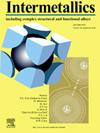Atomic structure evolution of magnetic HoErCo alloy metallic glass microwires at cryogenic temperatures
IF 4.3
2区 材料科学
Q2 CHEMISTRY, PHYSICAL
引用次数: 0
Abstract
The thermal strain in metallic glass (MG) can induce defect activation and alter the magnetocaloric properties, making it crucial to understand the atomic structure changes at cryogenic temperatures. This study investigated the evolution of the atomic structure and volume variation of HoErCo MG microwires as the temperature drops to the cryogenic level using in-situ high-energy synchrotron X-ray diffraction. As the temperature decreases, atomic vibrations diminish, and the disorder within the MG decreases due to cooling contraction, resulting in a reduction in average atomic volume. Through analysis of partial coordination numbers, the study revealed the formation of various solute-centered clusters during cooling. Specifically, larger rare earth (RE) elements tend to migrate toward the center of the clusters, while cobalt (Co) atoms move outward. In alloy microwires, RE atoms are more likely to aggregate with Co atoms, forming Co-RE clusters with Co at the center. This research provides a strategy for investigating the deformation and physical properties of amorphous alloys at cryogenic temperatures, potentially enabling accurate prediction of MG materials’ behavior under such conditions.
求助全文
约1分钟内获得全文
求助全文
来源期刊

Intermetallics
工程技术-材料科学:综合
CiteScore
7.80
自引率
9.10%
发文量
291
审稿时长
37 days
期刊介绍:
This journal is a platform for publishing innovative research and overviews for advancing our understanding of the structure, property, and functionality of complex metallic alloys, including intermetallics, metallic glasses, and high entropy alloys.
The journal reports the science and engineering of metallic materials in the following aspects:
Theories and experiments which address the relationship between property and structure in all length scales.
Physical modeling and numerical simulations which provide a comprehensive understanding of experimental observations.
Stimulated methodologies to characterize the structure and chemistry of materials that correlate the properties.
Technological applications resulting from the understanding of property-structure relationship in materials.
Novel and cutting-edge results warranting rapid communication.
The journal also publishes special issues on selected topics and overviews by invitation only.
 求助内容:
求助内容: 应助结果提醒方式:
应助结果提醒方式:


